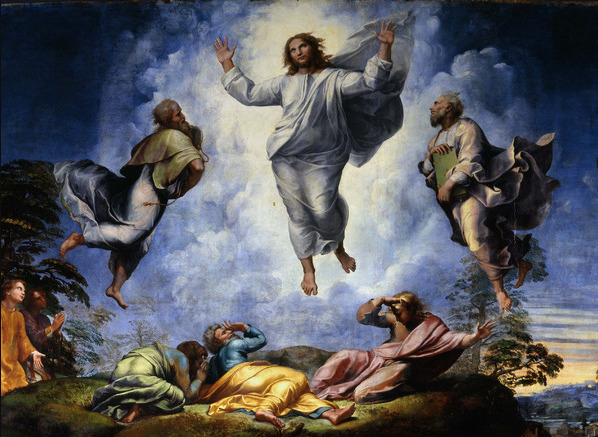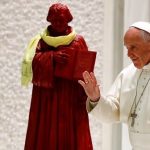Feast of the Transfiguration of the Lord – Year A

The Transfiguration according to Raffaello Sanzio (detail)
This is the feast of the revelation of the divine nature of Christ.
From the Gospel of Matthew: while on a mountain together with three apostles, the face and clothes of Jesus become very bright; Moses and Elijah also appear next to Jesus, representing the Law and the Prophets respectively: in Jesus the Old Testament finds its fulfillment. Then Peter, James and John are covered by a bright cloud, and a voice from the cloud proclaims that Jesus is the beloved Son.
A sign, through the glimmering of this intense light, which overcomes those men, and which we find testified in the Second Reading, by Peter who evokes his memory of that event. It is quite noteworthy, once again, this pertinacity with which Peter wants to convince the readers about the reliability of the testimony he is carrying.
Some psychology helps: obviously not to seek absolute certainty, but to understand how reasonably credible this whole story is.
A naively skeptical chap could emphasize the fact that Peter also tries to find support in the prophets, as if this indicated
1- his need to find alternative evidence, allegedly due to the weakness of his position, and
2- the concrete possibility that the Gospel accounts were invented and calibrated to stage the fulfillment of pre-existing prophecies.
Those who invent fictional stories tend to add suggestive details, don’t focus on their mere being there.
The messaging stems from a very clear and direct statement: “we had been eyewitnesses”. Then further reinforced by “We ourselves heard this voice”.
Even the best liars have hesitations; if they make the effort to invent they can sometimes go overboard by inventing big lies, but they hardly expose themselves with falsehoods of limited impact, which aren’t expected to impress the audience.
Here the signs of an experience converge, lived and perceived through multiple senses: at least sight and hearing. But for someone who reads or listens to those words, “we heard that voice” hardly adds anything, nor it changes one’s general impression. This is a patently obvious statement, if seen from the outside. It certainly doesn’t convince skeptics to insist “you have to believe me, I heard it!”
Yet in the face of rather modest expected results, adding any unnecessary statements costs stress and mental fatigue. Worse: it shifts the attention from the subject of the story to the person reporting; not only that’s against your instincts, but a liar would unconsciously try to hide in the shadows, far from turning the spotlight on himself again. Such choice would bring into play his credibility and call for new questions, with people asking for further clarifications, since he took the center of the scene. Hard.
Try to re-read the passage by removing the references to his direct experience: nothing is missing. Instead, in order to meet the public’s expectations, it would’ve been nice to add colorful details: why not describe, for example, the clothes of the prophets, the atmosphere, the outline?
Let me be clear: I’m not pretending anything can be demonstrated through this type of subtle reasoning. But these are clear indications of reliability, clues that are often found scattered within the text. It is the sum that makes the total, famously said the Italian comedian Totò.
Additionally, consider the opening for Luke’s Gospel, which insists on his questioning the witnesses to give an accurate account. Or we think of John who, faced with the fulfillment of the crucifixion (Jn 19:35), adds a series of observations that seem to insist obsessively on the same theme, perceived as crucial, something that one would like to communicate in the most convincing way possible:
An eyewitness has testified, and his testimony is true; he knows that he is speaking the truth…
A novel fixation: the truth, nothing but.
It seems that even believing exegetes nowadays tend to take for granted that the authors of these texts, indulging the literary styles and the taste and sensitivity of the time, felt free to invent characters and situations, simply because they seemed expedient for the purposes and teachings they focused on at a given moment; after all they couldn’t yet possess our modern notion of prioritizing the search for the truth, or the control of the sources…
But can you really imagine that the rigor of historians and (ideally) of today’s reporters arose spontaneously, for no reason, right here in Christian lands, and somehow these early Christians were instead eager to carelessly embellish stories, inserting fantastic details or convenient developments, without restraint? Are we talking about the same writers that seem to redouble their efforts to insert in their texts, out of the blue, assorted references to the truth, to their relying on eyewitnesses?
No. The most logical explanation is that they were convinced that they had witnessed something extraordinary. And they faced a cultural environment which, when not openly hostile, was at best willing to take their statements seriously only in a very oblique sense, with that suspension of disbelief which is typical of someone who lives religion as sort of a fairy tale for adults, but cannot put it on the same level as their tangible life experiences…
And that for this reason, as witnesses that were ready to pay with their lives for their faith, they spent so much energy insisting: no, this isn’t something that “one can believe in a certain sense”. These they are truly true, we have seen those events, we implore you, believe in what we say!
Try to reread the 2Pt reading in this perspective. Put yourself in the shoes of a Peter who speaks above all to people who hesitate and don’t want to believe that these accounts are really really true; he lets clearly transpire in the text all his emotional charge: of someone who knows what he’s saying, feels confident, but is frustrated not to be believed.
Here, therefore, he also mentions the prophets, but as an additional element:
Moreover, we possess the prophetic message that is altogether reliable
This above all tells me that Peter is following through a reasoning by additionally projecting on the prophets, which in any case contribute to a coherent framework, that sense of certainty that comes from what he retold before. And not vice versa.
Okay, once again these considerations, being based on our trying to put ourselves in the shoes of the author, are far from factual. But I believe this reconstruction fits much better.
The road that was prepared by the prophets
The fact that one can refer to the prophets does not mean at all that they are the true source of inspiration and the origin of the Gospel accounts, without there being concrete events at the root of the NT. There are countless cases where we moderns see New Testament authors venturing into OT quotes, alleging to have found fulfilled prophecies, which if anything seem quite a stretch. Large books could be written, and indeed were, just to expand on the concept of how different the gospels would have been if they had been based on prophecies.
In the First Reading we have a prophetic launch; from the book of Daniel, one of the prophets closest to the time of Jesus, indeed I’d say the last of those that later Judaism could not expunge from the canon (as it did with others, judged too close to the Christian and Hellenistic mentality of their time).
But if we’re to take it as a reference point, I certainly don’t see there a model, a possible source for the passage of the transfiguration of Christ that we find in the three synoptic gospels (Mark, Matthew and Luke, the first three gospels, so called because they are often overlapping, follow the same perspective, tend to relate the same stories).
Oh well, I don’t doubt that critics were able to find passages from the Old Testament that are somehow suitable for supporting their thesis: the Transfiguration as a story invented to follow a previous prophecy. But with what credibility? For example the bright cloud makes a comeback as a sign of God: think of the Jews encampment which was protected by this mysterious cloud in the book of Exodus. But could we really say that the mere presence of a returning element (the supernatural cloud) may be a sufficient reason to deny the historicity of the story?
The Elijah who was to come.
Or, and this is a more interesting observation: Elijah was expected to return during messianic times. Does this apparition respond to the need to fulfill that prophecy?
Let’s read how the book of Malachi ends. These verses also represent the conclusion of our Old Testament canon.
Malachi 3, 22-24 comes after a speech on the messianic time and the final judgment:
Remember the law of Moses my servant,
whom I charged at Horeb
With statutes and ordinances
for all Israel.
Now I am sending to you
Elijah the prophet,
Before the day of the LORD comes,
the great and terrible day;
He will turn the heart of fathers to their sons,
and the heart of sons to their fathers,
Lest I come and strike
the land with utter destruction.
Indeed, here they are, Moses and Elijah; furthermore Mark, the first gospel, when describing the transfiguration says that there were “Elijah with Moses”, reversing the hierarchy, which was obvious to any Jew, where Moses would take the place of honor. Here it’s implied that Moses was also there, as an extra, an afterthought.
Elijah in particular was expected as an envoy, in the world, to prepare the end times, based on Malachi 3: 1:
Now I am sending my messenger—
he will prepare the way before me;
And the lord whom you seek will come suddenly to his temple;
Where “messenger” here can also be understood as prophet: literally, the one who speaks on behalf of God.
Consider John the Baptist in the Gospel of John 1,19-25: let’s say also due to his extraordinary humility, when questioned he denied to be that prophet, or that Elijah, who was to come, as a precursor. But at that juncture, for the priests and Levites who questioned the Baptist, Elijah and the prophet who had to come to prepare the way were distinct figures, why? Perhaps they developed two separate expectations based on Malachi 3; the prophet of verse 1 and the Elijah of verse 23.
In fact, if you read it in a symbolic sense, you can appreciate how the Baptist is “sufficient” to fulfill both. Yet for them, the priests of the Pharisaic school, he could not represent the envoy, Elijah. And most would have taken an affirmative answer from the Baptist as proof of his claim to be Elijah himself, not just symbolically. Maybe that’s the most logical explanation as to why he replied that he wasn’t him.
But this concept of the role of the Baptist is well attested in the NT, since it’s also reiterated by Luke.
In fact in Matthew 11: 7-14 it is Jesus Christ himself who quotes Malachi and attributes to the Baptist the role of that prophet who prepares the way, adding:
And if you are willing to accept it, he is Elijah, the one who is to come.
Therefore of the role of Elijah the NT does something very different than expected: Elijah was expected to return in flesh and blood, to make himself recognized, to act, interact, indeed to prepare for the end of the world. And here’s someone who instead holds the role of Elijah symbolically, ushering in a new era which will then eventually also lead, in a future, to a second coming for the end of the world.
In this episode, however, we’re dealing with an apparition. During the transfiguration, the two figures appear in Jesus’ company but miss the opportunity to give any sign, beyond a mere presence. Not a word is spoken by them. As if to remain confined to an ethereal, almost dreamlike dimension.
No, the prophet Elijah who was to come, if they really wanted to invent an episode that met expectations, would have made his presence felt, would have acted. To convert hearts and reconcile fathers and sons, as announced.
Here we’re instead presented with a sign, which is interesting but adds almost nothing.
Consider: the fact that Mark puts Elijah first probably suggests that he had thought about the prophecy of Malachi, but he could not add some appropriate details at will, instead having to faithfully report the story of an apparition that, from this point of view, appears unsatisfactory nonetheless (!)…
These testimonies were reported earnestly and attributing to them significant value. That’s the most realistic assessment we can make of this situation, I’d say. They didn’t possess the meticulousness and concerns of a modern historian, but would still respect the original memory: imagine that instead of three shepherd children in Fatima, who insisted they saw the Virgin Mary and remained credible and convincing even through intense interrogation, here we find three apostles describing the Transfiguration.
Doubting the historicity, absolutely, that’s necessarily right! Especially for a historian, who must first of all consider how the writer’s point of view is anything but neutral.
But please, your haughtyness, keep it for some other occasion.
More than anything else, one suspects what’s really emerging here is pseudoscientific skepticism, which excludes manifestations of the supernatural on principle.
Then Blaise Pascal comes to mind:
How I hate this folly of not believing in the Eucharist, etc.! If the gospel be true, if Jesus Christ be God, what difficulty is there?
Let’s go back to Daniel.
There’s a incredibly old man, who represents God the Father, and then a man. He’s called son of man, but that’s just an alternative way of saying man, according to a stylistic convention of the time, do we want to call it poetic?
Jesus usually chooses to present himself with the same expression: the Son of Man indicated by Daniel, to recall – in a way that was initially somewhat discreet – his claim to be the announced Messiah.
It’s a vision, that one described by Daniel, presumably hard to grasp for his time, because he began to recognize this man had a distinctly peculiar role, not suitable for a mere human being: destined to reign forever, over everything and anything…
Again, this is subtle. Pushing the envelope enough to guide us towards the intuition of the divinity of this special figure, but without explicitly saying it, without directly causing the genesis of this shocking idea, and without alarming the careful Jewish defense of rigorous monotheism…
And now back to the Transfiguration.
Sorry if I seem to jump from topic to topic, but I wanted to put things in a proper order, where the puzzle pieces fall where they should, and what you see is my limited mental order at work.
I wanted to point out how rare this circumstance is: two readings that report the exact same sentence. And not just any words: the very voice of God that reveals the Son.
I’m just an ignoramus, nonetheless I tried to compare the original Greek texts, and they look indeed practically the same, with a minimal shifting of word order.
This is my beloved Son, with whom I am well pleased;
listen to him.
A phrase that, as mentioned, can be also found in the other two synoptic gospels, when they narrate the transfiguration.
It’s basically the same formula that is also found in Mark 1:11, Matthew 3:17 and Luke 3:22. In that case, however, the voice from Heaven reveals the Son on the occasion of the baptism in the Jordan.
I’d be curious to know if someone tried to translate it into Aramaic, or perhaps into Hebrew: as a formula I expect it to have had a prominent position in preaching and perhaps in primitive liturgy, therefore it would be interesting to check if a trace could be found of a possible Semitic linguistic substrate, a lost original, which perhaps had an easily memorized structure and perhaps a hint of musicality.
Alternative inventions?
The temptation of the skeptic is once again to see two alternative fabrications here: where would the voice from heaven have been heard?
– On the occasion of Jesus’ baptism,
– or on the mountain of the transfiguration, traditionally identified with Mount Tabor?
One could think of a pre-existing teaching in the form of a single sentence, creatively placed in one or the other fictional scene.
Sorry if I repeat myself: I don’t pretend to have determined that in the NT there were no inventions, deformations, shifts in timing and place, arbitrary rearrangement choices… In this field there are no demonstrations, and that’s even truer in this specific case. Regardless of the incompetence of yours truly.
These episodes, describing a voice from heaven, could be -at least in part- fictionalized? One the transposition of the other perhaps? I’m not denying that at all. A complete fabrication?
But consider: the synoptic gospels report both episodes! It doesn’t look reasonable to come up with these two stories, so similar to each other and potentially alternative, out of the blue; while at the same time playing the part of the scrupulous .
This is quite indicative: by far the cheapest and most logical explanation is that they collected two separate, pre-existing traditions.
Mythicalist theories draw strength from the idea, which is far from proven, and against which there are heavy clues, that a long time had passed between the events and the first drafts of the Gospels. But if that’s not the case, we have Luke collecting testimonies that had already coalesced a few years after the events, around the 70s. Mark should already possess a consolidated text in the 50s, that is, twenty years (or slightly more) after the events narrated, when Jerusalem and the Temple weren’t yet destroyed, and many witnesses, including opponents, were still alive.
And Matthew should be placed in the middle.
Whatever you may think of these quite uncertain temporal placements (and I have no doubt specialists would emit high howls at the sight of these dates which I carelessly quote, without a scholarly citation reference list to support them), the fact remains that there’s now an almost unanimous consensus: the order over time is Mark-Matthew-Luke, and their content are too close in agreement not to be interdependent. So either they stem from a common source (which was a fashionable theory a few years ago) or the writer that comes after knows the previous text and takes it into account, perhaps intending to reorder the material for a different audience, for pastoral needs – as we’d call them nowadays – or to add some details. In fact Mark is the leanest and shortest text, as well as being the first.
The idea of total fabrications collides with the difficulties that derive from this concordance.
So… two distinct occasions where the voice of God is revealing the Son appear together in one or more early sources, close to 20 years after the events of the Passion; they’re then acquired or confirmed by several parties over the course of a few decades. For a field, that of ancient history, where we often work with texts that date to centuries after the events narrated, and where the writer usually does not have to face the objections of adversaries, this short time span is truly remarkable. More than it may seem to the layman. For this reason, many scholars have worked tirelessly to build a case, to argue that the texts of the NT were as late as possible. To assume the worst and see malice in people’s behavior may be a sin, but it gets you closer to the truth; while it’s true that as believers we have a strong bias and may refuse to see the issues with the traditional version, we must recognize that the opposite prejudice typically applies to experts.
Moreover, it is not impossible for the Almighty God to reveal this important concept on two separate occasions!
If one were to be the transposition of the other, I would say that there are various reasons why the transfiguration would be the original episode, and the sign on the occasion of John’s baptism the derivative story. Peter’s insistence I was talking about earlier is a heavy clue of this: there is a vivid memory, a personal emotion, behind it.
And it’s easier to think of a revelation reserved to a few followers, accompanied with the instruction not to disclose it until later, than on a public occasion, which would have caused a stir ahead of time.
Having said that, however, allow me to get back to the example of the Sun miracle in Fatima, as I already didscussed: it is a relatively recent event; the bulk of testimonies that aren’t certainly forged tell us that undoubtedly something happened, whether supernatural or not; and involved crowds, even non-believers. Nothing prevents, strictly speaking (even from the point of view of an atheist, on similar premises!), experiences of such apparitions also with Jesus; moreover, nobody necessarily said that in the desert with John the Baptist there was a large crowd.
In summary: where would the idea this isn’t a reliable account stem from?
At any rate, the credibility of the transfiguration episode also lies in the fact that one doesn’t see a reason to invent such a striking episode, only to place it in secret, with only three apostles present. Reducing the number of witnesses for no gain.
Unless one says: “Uhm, but having close to zero witnesses means being able to freely invent any story, since there are no external criteria of validation!”
To which I would reply: “Oh-oohhh! Then you’re saying they couldn’t just write down anything they wanted; on the contrary, what mattered was the witnesses they could declare to be the source!”
So how do you explain the baptism in the Jordan river, with Luke saying that Jesus went to be baptized as all the people were doing it? Wasn’t such an episode, with numerous non-Christian witnesses, problematic at least?
Credibility of the Gospels
Can you appreciate why do I insist talking about a sort of complex interlocking puzzle? That’s because however you twist it, your alternative explanation always falls short. If the skeptic means that here it’s all about arbitrary fabrications, why so many missed opportunities, with inappropriate and embarrassing details, missing pieces, limited testimonies? If, on the other hand, it was necessary to respect the limits given by real life experiences, then there’s a solid historical basis behind these religious texts, after all.
-If you could give free rein to your imagination, why only three witnesses to the transfiguration?
-If one had to respect the reality of the facts known to most (such as the faction of the followers of the Baptist or the observant crowds, doctrinally close to the Pharisees) then how do you explain the voice from Heaven for the baptism of Jesus?
Of course, nothing is impossible and history is always complex and facts are different and distinct from our imprecise accounts, but let’s stipulate that the version of the unbeliever cannot be taken for granted so quickly, as it happens these days.
For example, it could be assumed that two different traditions, one free to invent, the other more scrupulous in reporting, have been put together and superimposed in some way, then uncritically received and thus put in writing, but at this point even such airy reconstruction dwells in the realm of plausible fiction. It’s definitely not easy to come up with an alternative puzzle of events that holds up, and on what would it rest anyway?
The crowds at the Jordan, one might say, were added by Luke which comes last, and they weren’t necessarily intended as present at the same precise moment as Jesus…
Yes, but for that matter, the skeptic can say that the baptism scene is a total fabrication, and in reality Christians were interested in pretending to have obtained the endorsement of John the Baptist, which had a remarkable following: making him an announcer of Jesus. But if they could create the scene of a meeting that never happened so freely, then what was left of John’s followers? To the extent that one believes that the evangelists could appropriate the Baptist by exploiting his prestige, one is also implicitly admitting that not much remained of the Baptist’s legacy and followers, thus making it less interesting to try to appropriate it.
Beyond that, the more -as an observer- you try to unshackle those stories from facts and from the need to report them earnestly, the more this whole endeavor becomes an arbitrary exercise, which does not rest on solid foundations and explains nothing, indeed it clashes with the shape and appearance of the data we have in our hands. Even Rousseau, far from a friend of the Christian faith, faced with the Gospel, says:
The death of Socrates, philosophizing tranquilly with his friends, is the sweetest one could desire; that of Jesus, expiring in torment, insulted, jeered at, cursed by a whole people, is the most horrible one could fear. Socrates, taking the poisoned cup, blesses the man who gives it to him and who is crying. Jesus, in the midst of a frightful torture, prays for his relentless executioners. Yes, if the life and death of Socrates are those of a wise man, the life and death of Jesus are those of a god. Shall we say that the story of the Gospel was wantonly contrived? My friend, it is not thus that one contrives; the facts about Socrates, which no one doubts, are less well attested than those about Jesus Christ.
And considering that we don’t have to expect to get some new useful information on these matters in the future, destructive criticism becomes an even more sterile and silly exercise, because we’ll never have the decisive answer, which may convince everybody, in this life.
I don’t pretend to be able to reach any level of certainty; however you may appreciate how, by delving deeper, the point of view of those who trust the content of the Gospels turns out to be healthy and certainly credible, even in a world of skeptics who don’t want to believe in anything. Healthy, realistic, substantially reliable, but pay attention: we don’t have the pretense to take it literally and believe that every single word is true, every piece of content reported precisely and faithfully.
We shall always remember the Catholic criterion: the Bible is not wrong in what it intends to teach, but it’s a human book, imperfect, for anything that surrounds it.










































